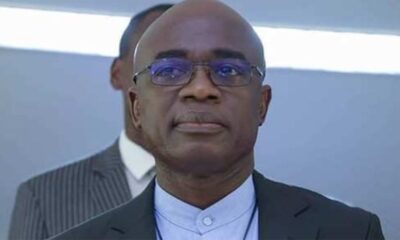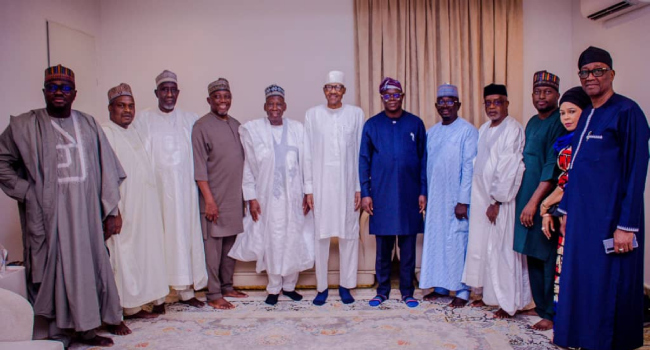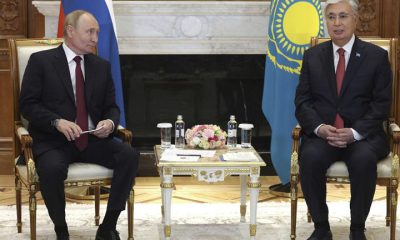Politics
INEC gives reasons why upload of 2023 presidential election result was slow
Published
1 year agoon
By
Ekwutos BlogSome Months after claiming that an attempted hack led to the slow upload of the 2023 presidential election result on its election viewing portal (IRev), the Independent National Electoral Commission has said that the issue was caused by an unforeseen configuration issue in integrating the presidential election upload into the system.
INEC, in a 526-page report on the conduct of the 2023 general elections also noted the currency swap issue and fuel scarcity within the period also impacted negatively on the elections.
The commission also said that while the configuration problems experienced at the commencement of result upload were immediately addressed, further delays arose as a result of the Polling Officers either switching off their devices or leaving their locations, making it difficult for their IREV to communicate with the device.
It noted that several results that were scanned earlier before the glitch queued up for upload, making the system slow, thereby delaying some of the uploads till the following day.
INEC also said it suffered over 50 attacks on its buildings and facilities in various LGAs and State Offices across 15 States of the federation leading to losses in terms of vehicles, office equipment and election materials.
The commission also insisted that the 2023 general election remains diverse in terms of representation both at the state and federal levels as more political parties won elections in either the state Assemblies or the National Assembly with four parties- APC, PDP, LP and NNPP winning governorship elections.
The Report, with a foreword by the Commission Chairman, Prof. Mahmood Yakubu read;
“On the 25th of February 2023, the nation held the Presidential and National Assembly Elections. These elections were notable for their peaceful and orderly conduct, marked by the absence of significant instances of violence, with over 25% of registered voters casting their ballots.
“Polls opened on time in most polling stations and were generally smooth and orderly. There were some reports of technical glitches with the BVAS, although these were addressed by the roving technical staff assigned to address such issues. The counting, collation, and declaration of results process were largely peaceful, transparent, and credible nationwide.
“While the former was tailored to serve as the nerve centre for monitoring the conduct of elections across the 774 LGAs nationwide, the latter served as the venue for the National Collation of results emanating from States. Throughout the electoral process, Election Monitoring Support Centres (EMSCs) in every state served as a vital source of field information and intervention.
“The National Situation Room was also set up for the conduct of the Governorship and State Houses of Assembly Elections, held on the 18th March 2023. This time, it was replicated in all 36 states. The Situation rooms both at the national and State level were managed by a team of experts from INEC, the security agencies and other relevant organisations.
“A key challenge that impacted on the public perception of the election and elicited widespread commentary was the failure to upload Polling Unit results of the presidential election to the INEC Result Viewing (IReV) portal in real-time at the close of polls on Saturday 25th February 2023”
“To begin with, it is important to note that the IReV portal is one of the most significant innovations introduced by the Commission prior to the 2023 General Election to promote the integrity and transparency of the electoral process. As a public-facing website, the IReV portal shows the images of the original Polling Unit result sheets as recorded in Form EC8A.
“The operational methodology and the concept behind the upload of results to the IReV for public viewing is quite simple. At the end of polls, Polling Unit results (Form EC8As) are scanned and uploaded to the IReV by the Presiding Officer(s). These results are then available for viewing to the public and all stakeholders.
“The system, which was first deployed during Nasarawa Central State Constituency bye-election in August 2020 and tested in 105 subsequent elections, including three (3) off-cycle governorship elections, has tremendously improved public confidence in the integrity and transparency of the Commission’s result management process.
“The challenge of uploading the PU presidential election results on the IReV after the presidential and NASS elections on 25th February 2023 was unique. As voting ended across the country and POs began the process of uploading the images of the PU result sheets of the elections for the various constituencies around 1 4:00pm, the Commission began to receive reports that attempts to upload presidential 4 election result sheets was failing.”
You may like


Troops neutralize bandits, recover arms in Plateau


Emergency rule: NBA leadership not fighting enough for our democracy – CSO


Governor Alia lied about Benue IDPs data – Shior


APC ‘Retaliates’ As Ganduje Leads Delegation On Visit To Buhari


Lagos holds LG polls July 12


Killings: Benue is bleeding while you fight for power — APC chieftain, Inedu tells Gov Alia in open letter
Politics
Governor Alia lied about Benue IDPs data – Shior
Published
2 hours agoon
April 12, 2025By
Ekwutos Blog
Emmanuel Shior, the immediate past Executive Secretary of the Benue State Emergency Management Agency (SEMA), has faulted the claims by Governor Hyacinth Alia that his administration did not inherit any data on the Internally Displaced Persons (IDPs) within the state.
In a statement made available to journalists in Makurdi, Dr. Shior expressed concern over the governor’s assertion, questioning whether the administration also lacks data on the Cameroonian refugees that the state is currently hosting.
He emphasized the importance of accurate data in addressing the humanitarian crisis stemming from escalating insecurity in the state, which has resulted in a growing IDP population.
“Governor Alia’s claim is a misrepresentation of the facts. In my handover notes, I documented data indicating approximately two million IDPs and around ten thousand Cameroonian refugees in Benue State,” Dr. Shior stated.
The former Executive Secretary of Benue SEMA, who is a lecturer at the Federal University of Lafia, emphasized that the previous administration established strategic partnerships and conducted symposiums aimed at generating reliable data for effective IDP management.
This collaborative effort, he said, included partnerships with various national and international organizations such as NEMA, UNHCR, and UNICEF, culminating in the creation of the Benue State Humanitarian Response Plan.
Shior noted that Governor Alia had previously acknowledged the same data in media presentations and discussions with humanitarian partners and wondered why the governor has suddenly turned around to speak in a contradictory tone.
“What is particularly ironic is that while the governor claims to have improved conditions for IDPs, new camps are being established without adequate provisions for their welfare,” he said.
Politics
APC ‘Retaliates’ As Ganduje Leads Delegation On Visit To Buhari
Published
2 hours agoon
April 12, 2025By
Ekwutos Blog
The visit took place hours after former vice president Atiku Abubakar led the People’s Democratic Party delegation on a courtesy call to the former president.
In a retaliatory move, the National Chairman of the All Progressives Congress, Abdullahi Ganduje, on Friday, led members of the party’s National Working Committee on a visit to former President Muhammadu Buhari at his residence in Kaduna State.
The visit took place hours after former vice president Atiku Abubakar led the People’s Democratic Party delegation on a courtesy call to the former president.
The delegation included former Governor of Kaduna State, Nasir el-Rufai; former governor of Sokoto, Aminu Tambuwal, former governor of Imo State, Achike Udenwa; former governor of Benue, Gabriel Suswam; former governor of Adamawa, Jibrilla Bindow; former Minister of Justice and Attorney General of the Federation, Abubakar Malami, and former Minister of Communications, Isa Pantami.

Speaking with reporters after the meeting, El-Rufai said the visit to the former president was not political and asked “adversaries” not to lose sleep.
The former Minister of the Federal Capital Territory added that the visit was for “unity and brotherhood”.

The outcome of the APC NWC’s visit remains unknown; there have been speculations of disunity in the party, as some members of its members recently defected to the Social Democratic Party.
Atiku also cleared the air on Friday, saying that the visit was for the Sallah celebration as against speculated coalition talks.
In a post on his official X handle, Atiku wrote, “As the Waziri Adamawa, I was obligated to be in Adamawa during the Sallah celebrations. I held forth for the Lamido Fombina (Adamawa) in some of the activities of the Sallah celebrations. Today, I had the opportunity to pay a post-Sallah visit to His Excellency, Muhammadu Buhari, President of the Federal Republic of Nigeria, 2015-2023. It was a wonderful time with him. As usual, he cracked me up (to the extent that my ribs were hurting) with his peculiar humour.”

The Lagos State Independent Electoral Commission (LASIEC) has scheduled the state council election for July 12.
Mr Tope Ojo, LASIEC’s Head of Public Affairs, made this announcement on Friday in Lagos.
He revealed that the election for 57 council chairmanship positions and 376 councillor seats will take place on July 12. If necessary, a re-run will occur on July 19.
Lagos State comprises 20 Local Governments and 37 Local Council Development Areas (LCDAs).
The election date was chosen to avoid a leadership vacuum in the state’s councils.
LASIEC’s notice confirmed that the election will include 20 Local Governments, 37 LCDAs, and 376 wards.
With the current local government administration nearing its end, LASIEC has ramped up efforts for a smooth election process.
The commission has officially launched the electoral process with the release of the Notice of Election.
Political parties must visit the LASIEC headquarters to obtain nomination forms for their candidates.
Ojo confirmed that a meeting with all registered political parties is set for Tuesday.
“The Election Guidelines will be published on April 17,” Ojo added.
According to him, campaigns and rallies will start on April 18 and end on July 9.
Nomination Forms for “substituted” and “only candidate” submissions must be submitted between June 18 and June 25.
LASIEC Chairman, Justice Bola Okikiolu-Ighile (rtd), assured a fair and level playing field for all political parties.
He reaffirmed the commission’s commitment to holding a free, fair, inclusive, and credible election.
Okikiolu-Ighile encouraged political parties and aspirants to strictly follow the electoral timetable.

Troops neutralize bandits, recover arms in Plateau

Emergency rule: NBA leadership not fighting enough for our democracy – CSO

Governor Alia lied about Benue IDPs data – Shior
Trending

 Trending6 months ago
Trending6 months agoNYA demands release of ‘abducted’ Imo chairman, preaches good governance
- Business6 months ago
US court acquits Air Peace boss, slams Mayfield $4000 fine

 Politics6 months ago
Politics6 months agoMexico’s new president causes concern just weeks before the US elections
- Entertainment6 months ago
Bobrisky transferred from Immigration to FCID, spends night behind bars
- Entertainment6 months ago
Bobrisky falls ill in police custody, rushed to hospital

 Politics6 months ago
Politics6 months agoRussia bans imports of agro-products from Kazakhstan after refusal to join BRICS

 Politics6 months ago
Politics6 months agoPutin invites 20 world leaders
- Politics1 year ago
Nigerian Senate passes Bill seeking the establishment of the South East Development Commission.

